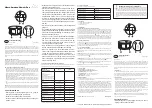
Pro Cube
K+R Performance Engineering, Inc.
7
opponent's dial-in, and 1.035 for both
DELAY 1
and
DELAY 2
. The difference between the dial-in's (cross-
over delay) will be automatically calculated and added to
DELAY 1
(1.035). Stage your car and depress both
trigger switches. The transbrake will be activated. Release
TRIGGER 1
when the opponent's tree starts.
Release
TRIGGER 2
when your tree starts. You will launch on the quicker reaction. If your reaction time
was quicker on your tree by 0.009 seconds the display will show 0.000 in the left window, and 0.009 in the
right window for reaction time information. A bump-down count of 0 will appear every 4 seconds in each
window indicating that you did not use the feature.
Your time slip indicates your actual reaction time was 0.515. This was your reaction time to your
side of the tree. The reaction time information indicated you were 0.009 slower reacting to your opponent’s
tree, so your actual reaction to your opponent's side of the tree would have been: 0.515 + 0.009, or 0.524.
Example 2:
You're using Dual Trigger interface mode. After staging, the starter takes longer than usual to start
the tree and you flinch, releasing the trigger switch too soon. Just press the switch again and release it when
the tree starts. If you're late, use Bump-Down to correct for it. (In Dual Trigger mode, the delay timers are
reset whenever the trigger switches are depressed, and started over when released.)
Example 3:
You're using Single Trigger interface mode. You hit the cross-over bulb and press the transbrake
switch again to hit your top bulb, but your finger slips off the button before your tree is activated. To avoid
the pending red-light, just depress and hold the transbrake switch until the bottom of your tree. (In Single
Trigger mode the
Flinch Protection
Ò
feature will not release the transbrake if the switch is depressed.) Release
the switch near the bottom of your tree for instant launch.
Example 4:
You’re racing a Pro tree and equipped with a throttle stop. You’re in “Pro tree” run mode with times
set in
TIMER 1
to control the throttle stop, and you have the bump-down set for .020. When the car lauches
you feel the tires spin. When the throttle stop comes on the first time, you tap the bump-down switch once.
You still feel you’re not going to be able to “run the number”. The throttle stop comes on again and you tap
the bump-down twice. After the run the display shows 0 in the left window and 3 in the right window,
indicating you bumped-down
TIMER 1
a total of 3 times. So you subtracted .020 seconds from stage 2, and
.040 seconds from stage 4 of
TIMER 1.
TIPS FOR ADVANCED RACERS
1.
If you bracket race and also Pro tree race, use the Full/Pro tree select feature to store your delay and
timer settings for each type of racing. In Pro tree mode “Pro” is displayed where you would normally
set dial-in times. (This feature is purely for convenience and is available in timer versions only.) Note:
This allows two totally different “Run programs”.
2.
Use a timer with the
Pro-Stage
™
system to setup a “programmed dump” near the finish line.
Connect a jumper wire from the
Pro-Stage
™
to the Timer output so that the timer can also
activate the
Pro-Stage
™
throttle stop. The
Pro-Stage
™
throttle setting is at near idle which
will provide quick deceleration and make it virtually impossible for a faster opponent to judge a slim
victory.
3.
Use a timer for extremely accurate shifts. Set the timer for “normally off” mode and adjust the ON
time for when you want the shift to occur (this may require a little experimentation). Add 1 second to
the ON time and use that for the OFF time to send a 1 second pulse to the shifter.
4.
Want two shots at the tree without crossing-over? Set the unit for Dual Trigger mode and hook up
both trigger switches on your steering wheel. Set
DELAY 1
and
DELAY 2
for the same delay time.
When you stage, press both trigger switches, one with your left hand and one with your right.






























